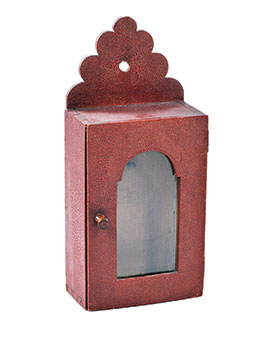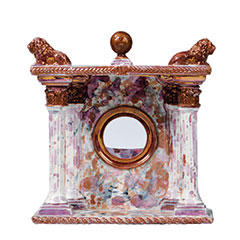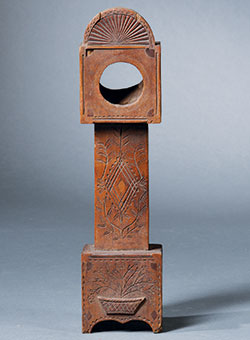Time Stands Still
Writer Leslie Gilbert ElmanThere was a time when everyone owned a watch stand.
Caring for a pocket watch in the 18th and 19th centuries could be a 24-hour-a-day proposition. Watch owners didn’t mind the effort. An object so useful, so beautiful and so finely crafted deserved proper treatment. Thus, after days hanging from a watch chain, it was fairly common for a watch to spend its nights nestled inside a soft, padded watch pocket that dangled from the curtains or a post of a four-poster bed. More interesting, and certainly more decorative, was the watch stand, or watch hutch, a tabletop object devised specifically to hold a pocket watch when it wasn’t being worn.
“It’s an object with a very esoteric use that, once you understand it, falls into the category of a conversation piece,” says Chris Barber, deputy director of American Furniture and Decorative Arts at Skinner Auctioneers in Massachusetts. “We [at Skinner] all like them because they’re such interesting personal objects with such a singular utilitarian purpose.
“Watches run more accurately when they’re hung,” Barber explains. “A watch hutch kept the watch safe. It also provided an extra layer of protection from dust and soot.” Placing a running watch on the hard, flat surface of a table or mantel wasn’t recommended because the vibration of the watch housing against a hard surface could cause its internal works to falter. Tucking the watch under one’s pillow at night (which many people did) also was not the ideal way to care for it.
Typically, the watch stand would have been placed in a private room such as a bedroom where other personal effects were kept, possibly on a desk or a bedside table. (In the investigation of Lord William Russell’s murder in 1840, his watch stand was a notable piece of evidence. It was found in its usual place on his bedside table, but the watch was missing!)
Go Set a Watch Stand
An English ladies’ magazine of the 1850s stated the watch stand was “one of the fanciful ideas of the French.” Although it’s not certain that watch stands originated in France, the idea seems reasonable given that France was known for producing fine watches.
The French magazine La Nature in 1901 put the origin of the watch stand—called a porte-montre in French—in the late-17th or early 18th century. It noted the popularity of watch stands reached a peak during the reign of Louis XVI (1774-1792), ebbed slightly during the French Revolution and revived during the French Empire of Napoleon (1804-1814).
Watch stands certainly were common in England, throughout Europe and in the United States. There’s a record of ormolu watch stands being part of the “elegant assortment” of objects for sale at “Mr. Christie’s auction room” in London in 1772. A Miss Rebecca L. Prince of West Medford, Massachusetts, was awarded a papier-mâché watch stand for excellence in Latin recitations at the Mystic-Hall School in 1856. And an 1866 article about Alexander H. Stephens, vice president of the Confederate States of America, mentioned that he owned an embroidered one.
Watch What Happens
Travelers brought home carved ivory watch stands as souvenirs from India, and sailors made scrimshaw watch stands from whale’s teeth. (There’s one in the collection of the Smithsonian.) The Staffordshire potteries in England produced lovely hand-painted china examples. An article about the Malaysian latex material gutta-percha mentions its usefulness for making watch stands. There are countless examples of elaborate watch stands made to resemble grandfather clocks, feminine watch stands in the shape of slippers and very simple watch stands handcrafted from wood and decoratively painted.
In its April 24, 1858, issue, an English periodical called The Work-Table, the Lady’s Newspaper gave detailed instructions for crafting a flower-shaped watch stand from wire wrapped with yarn. Indeed project patterns for making watch stands in all sorts of materials, from wood to velvet-covered cardboard, appeared frequently in 19th-century magazines for women and children. They were popular gifts, verging on ubiquitous. Then they all but disappeared from use, as fashion changed with the introduction of the wristwatch in the 20th century.
Today’s collectors love the fact that so many watch stands were made in so many ways under so many circumstances. “As a watch hutch collector, you can have a pleasingly eclectic variety of objects in your collection,” Barber says. “Or, for example, you can be a collector of silver and have a silver watch stand that fits brilliantly into your collection. We sell many of them as individual pieces of folk art. There’s a huge variety—masculine or feminine, manufactured or handmade. One of the things I enjoy is the story these objects can tell about who used it, what that person liked, what that person did, all because of the different ways a watch hutch can look. People used to put so much effort into the things they surrounded themselves with.”
Leslie Gilbert Elman, author of Weird But True: 200 Astounding, Outrageous and Totally Off the Wall Facts, writes about antiques and other subjects for Design NJ.




